Solute Transport and Mixing
Contaminant transport in water distribution systems is a growing concern due to the potential for accidental or intentional contamination events. Understanding and predicting solute transport through water distribution pipe networks are crucial to mitigate potential contamination events through risk assessments, vulnerability assessments, and contaminant source detection.
Problem
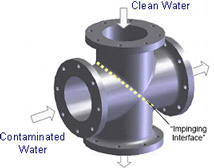
The transport of contaminants through water-distribution pipe networks depends on mixing at pipe junctions, where different flow rates and contaminant concentrations can exist.
Many water-distribution network models such as the U.S. Environmental Protection Agency’s EPANET software, an industry standard for modeling hydraulic and water-quality behavior, assume contaminants mix instantaneously and completely in pipe junctions.
The assumption of complete-mixing in pipe junctions is contrary to recent experimental and computational studies, which show that solute mixing in pipe junctions is incomplete. The common assumption of complete-mixing thus leads to potentially inaccurate transport predictions.
Computational Approach
Computational fluid dynamics models of pipe joints were developed to provide detailed visualizations of the mixing behavior within junctions, in order to guide the development of our new mixing model.
In agreement with our experimental studies, these rigorous computational studies found that fluid streams entering a cross-junction tended to bifurcate, depending on the relative momentum of the fluid streams, which resulted in incomplete mixing.
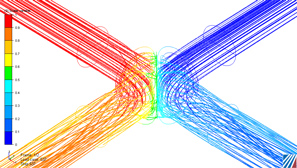
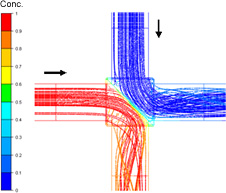
cross-junction
Experimental Approach
A series of experiments were performed to characterize the mixing behavior within individual pipe joints. Different joint configurations (“cross” and “double-T”) were evaluated, along with different pipe diameters, flow rates, and spacing between “T” fittings. The results of these experiments were used to calibrate computational fluid dynamics models for simulation of larger multi-joint networks.
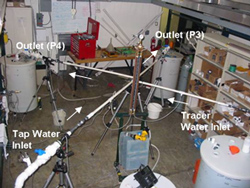
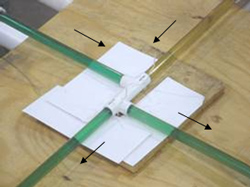
Incomplete mixing was observed for “T-spacings” less than 10 diameters, and the most prominent incomplete mixing behavior occurred in cross-joints. The focus of the research was thus directed toward studying the incomplete mixing behavior in cross-joints.
Small-scale multi-joint networks consisting of arrays of cross-joints were also developed to validate multi-joint computational studies.
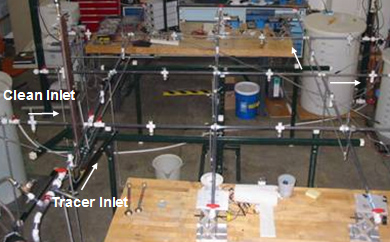
New Bulk Advective Mixing Model and EPANET-BAM
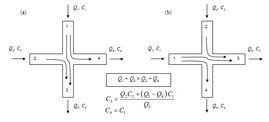
We have developed from our experimental and computational studies a new mixing model to predict concentrations of an aqueous solute resulting from two pipe flows intersecting at a cross-junction.
Our new Bulk Advective Mixing (BAM) model honors the observed incomplete-mixing behavior by retaining bulk fluid momentum. It also neglects turbulent diffusivities and instabilities at the impinging interface. Therefore, Bulk Advective Mixing is a lower bound to the amount of mixing that can occur in a junction, whereas complete-mixing is an upper bound.
EPANET-BAM
We implemented the Bulk Advective Mixing (BAM) model into EPANET 2.00.10, open-source software distributed by the U.S. Environmental Protection Agency that models flow and contaminant transport through water distribution pipe networks.
EPANET-BAM, our new augmented BAM-enabled version of EPANET, uses a mixing parameter to scale between the predictions of the complete-mixing and BAM model solute concentration predictions.
More information, downloads and tutorials on EPANET-BAM are available from the website: https://www.sandia.gov/epanet-bam/ (resource no longer available)
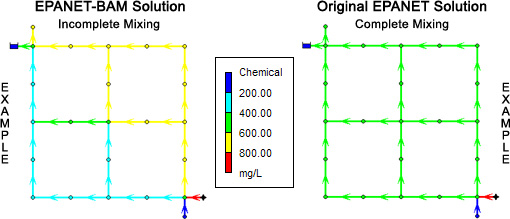
Publications
- Austin, R.G., B. van Bloemen Waanders, S.A. McKenna and C.Y. Choi, 2008, Mixing at Cross Junctions in Water Distribution Systems. II: Experimental Study, Journal of Water Resources Planning and Management, 134(3), 295-302. (SAND2007-4120J)
- Gomez, P.R., C.K. Ho, and C.Y. Choi, 2008, Mixing at Cross Junctions in Water Distribution Systems. I: Numerical Study, Journal of Water Resources Planning and Management, 134(3), 285-294. (SAND2007-0774J)
- Ho, C.K. and L. O’Rear Jr., 2009, Evaluation of Solute Mixing in Water Distribution Pipe Junctions, Journal American Water Works Association, 101:9, pp. 116-127. (Download 700 KB)
- Ho, C.K., 2008, Solute Mixing Models for Water Distribution Pipe Networks (provides original derivation of the Bulk Advective Mixing model), J. Hydraulic Engineering, 134(9), 1236-1244. (SAND2008-0166J)
- Ho, C.K., and S.S. Khalsa, 2007, An New Model for Solute Mixing in Pipe Junctions: Implementation of the Bulk Mixing Model in EPANET, presentation to EPA, October 11, 2007 (SAND2007-6646P).
- Ho, C.K., C.Y. Choi, S.A. McKenna, 2007, Evaluation of Complete and Incomplete Mixing Models in Water Distribution Pipe Network Simulations, in Proceedings of the 2007 World Environmental and Water Resources Congress, May 15-19, 2007, Tampa, FL. (SAND2007-0492C)
- Ho, C.K., L. Orear, Jr., J.L. Wright, and S.A. McKenna, 2006, Contaminant Mixing at Pipe Joints: Comparison Between Laboratory Flow Experiments and Computational Fluid Dynamics Models, in Proceedings of the 2006 Water Distribution System Analysis Symposium, Cincinnati, OH, August 27-30, 2006. (SAND2006-3583C)
- Khalsa, S.S. and C.K. Ho, 2007, Improving Contaminant Mixing Models for Water Distribution Pipe Networks, presented at the 2007 Sandia National Laboratories Student Internship Program Symposium, Albuquerque, NM, August 7, 2007. (SAND2008-0066P)
- McKenna, S.A., L. Orear, J. Wright, 2007, Experimental Determination of Solute Mixing in Pipe Joints, in proceedings of: ASCE World Environmental and Water Resources Congress, Tampa, FL, May, Tampa, FL, May 15-19th. (SAND2007-0496C)
- Orear, L., G. Hammond, S.A. McKenna, P. Molina, R. Johnson, T. O’Hern, and B.G. van Bloemen Waanders, 2005, Physical Modeling of Scaled Water Distribution System Networks, Sandia National Laboratories, Albuquerque, NM. (SAND2005-6776)
- Webb, S.W. and B.G. van Bloemen Waanders, 2006, High Fidelity Computational Fluid Dynamics for Mixing in Water Distribution Systems, in Proceedings of the 8th Annual Water Distribution System Analysis Symposium, Cincinnati, OH, August 27-30, 2006. (SAND2006-3834C)